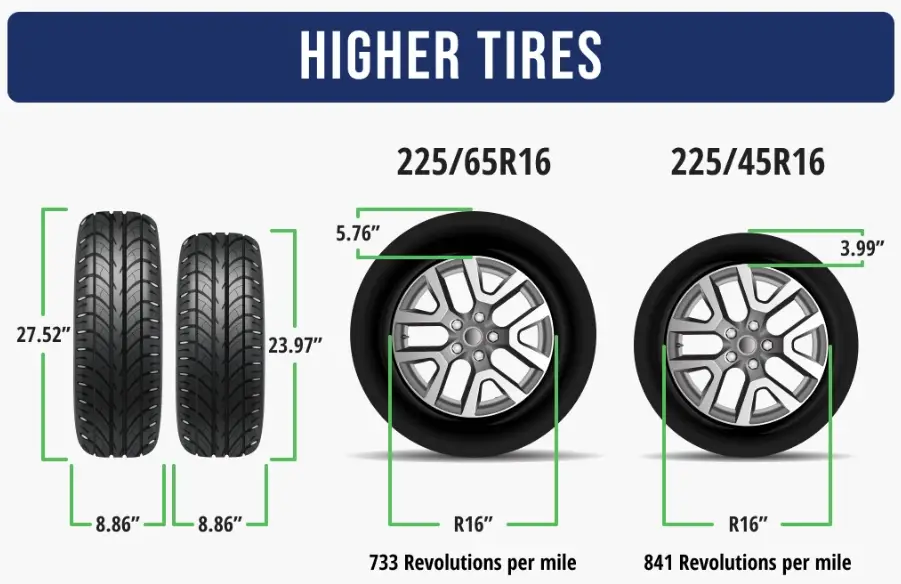Can I put bigger tires on my car? Yes, you can put bigger tires on your car, but it’s important to consider the potential impact on performance, handling, and clearance. Upgrading to larger tires can improve traction and appearance, but it may require modifications to avoid rubbing and ensure proper fitment.
When considering tire upgrades, one of the most common modifications is installing bigger tires. Many vehicle owners ask, “Can I put bigger tires on my car?” While this is a popular modification, it’s essential to understand the impact of larger tires on your vehicle.
Installing larger tires can have several benefits, including aesthetic upgrades and better performance, but it also comes with certain challenges and potential risks. This article will provide you with everything you need to know before deciding to put bigger tires on your car.

Contents
What Does Tire Size Mean?
Tire size is generally written in a specific format, such as 225/45R17, and each component of this size has significance.
- Width: The first number (e.g., 225) indicates the tire’s width in millimeters. The wider the tire, the more surface area it covers.
- Aspect Ratio: The second number (e.g., 45) is the aspect ratio, which represents the height of the tire’s sidewall as a percentage of the tire’s width. A smaller number means a shorter sidewall, and a larger number means a taller sidewall.
- Rim Diameter: The final number (e.g., 17) indicates the diameter of the wheel in inches that the tire is designed to fit.
When thinking about putting bigger tires on the car, knowing how each part of the tire size affects the vehicle’s performance and fitment is crucial. Larger tires typically mean a bigger width or a higher aspect ratio, which can lead to better traction or aesthetics, but also potential issues with clearance or suspension strain.
Can I Put Bigger Tires on My Car?
The Simple Answer: Yes, But With Caution
It is possible to put bigger tires on the car. However, the decision to do so should not be taken lightly, as it involves several considerations that can affect the vehicle’s performance, safety, and handling. Larger tires may look appealing and offer certain functional benefits, but they also present a number of challenges. Here are the pros and cons of upgrading to bigger tires.
The Benefits of Installing Bigger Tires
Upgrading to bigger tires can bring several advantages to the vehicle, depending on your needs. From improved aesthetics to better performance, these benefits can enhance the overall driving experience. Let’s take a closer look at the key advantages of installing bigger tires.
1. Enhanced Aesthetics
One of the primary reasons car owners upgrade to bigger tires is for improved aesthetics. Larger tires can give your vehicle a more aggressive, rugged, or sporty appearance. Whether you have a truck, SUV, or sports car, upgrading your tire size can make a noticeable difference in how your car looks on the road.
- Visual Appeal: Bigger tires can make your car look more robust and imposing, providing a bold look that attracts attention.
- Customization: Many vehicle owners use bigger tires to personalize their vehicles and set them apart from the crowd. Custom wheels paired with oversized tires are a common trend.
2. Improved Traction and Performance
Larger tires can increase the traction between your vehicle and the road. A larger tire provides a bigger contact patch, which means better grip, especially when cornering or accelerating. This is particularly advantageous for vehicles used in off-roading, as larger tires can dig into loose surfaces like mud, sand, or snow.
- Better Grip: Larger tires provide more surface area, resulting in improved grip, which is essential for off-road adventures.
- Off-Roading Capability: For trucks and SUVs, bigger tires can improve off-road capabilities, making it easier to navigate rough terrains and obstacles.
3. Increased Ground Clearance
One significant advantage of bigger tires is increased ground clearance, which can be especially beneficial for off-road vehicles. A higher ride height can help your car clear obstacles such as rocks, tree branches, or rough trails without scraping the undercarriage.
- Clearing Obstacles: Off-road vehicles with larger tires can tackle challenging terrain without hitting the ground.
- Improved Approach and Departure Angles: Larger tires can improve the approach and departure angles, which are essential for off-roading and avoiding body damage when climbing or descending steep obstacles.
4. Improved Towing Capacity
For vehicles used for towing, larger tires can provide increased load-bearing capacity. Bigger tires can support heavier weights and contribute to a smoother towing experience, particularly on uneven terrain.
- Increased Load Capacity: Larger tires can handle the additional weight of trailers or heavy cargo more effectively.
- Smoother Towing: Bigger tires help distribute the load more evenly, reducing strain on the suspension system and providing a more stable towing experience.

The Downsides of Installing Bigger Tires
While larger tires can offer numerous benefits, they also come with several potential drawbacks that can affect the vehicle’s performance and safety. It’s important to consider these challenges before making the decision to upgrade to bigger tires.
1. Altered Speedometer Accuracy
One of the most important issues to consider when putting bigger tires on your car is how it can affect your speedometer and odometer readings. Larger tires have a different circumference than the original tires, which means your vehicle will travel further with each rotation of the wheel.
- Speedometer Inaccuracy: Larger tires can cause your speedometer to read slower than your actual speed, leading to potential speeding violations.
- Odometer Inaccuracy: Your odometer might record fewer miles than you actually drive, which could affect the resale value of your vehicle.
2. Potential Suspension and Handling Problems
Bigger tires can significantly alter the handling of your vehicle. A larger diameter tire or a wider tire can put additional stress on the suspension components, which may lead to premature wear and tear.
- Suspension Stress: Bigger tires increase the weight and size of the wheel, which can strain the suspension system and result in a less comfortable ride.
- Handling Issues: Larger tires can change the vehicle’s center of gravity, which may result in increased body roll or reduced stability, particularly in sharp turns or high-speed maneuvers.
3. Increased Fuel Consumption
Larger tires increase the rolling resistance of your vehicle, which requires more energy to move. This increase in resistance can result in reduced fuel efficiency, leading to higher fuel costs over time.
- Reduced Fuel Economy: Bigger tires generally weigh more and create more drag, requiring the engine to work harder to maintain speed.
- Long-Term Costs: While the initial tire upgrade may seem appealing, the long-term cost of decreased fuel efficiency can add up quickly.
4. Potential for Tire Rub and Clearance Issues
When you install larger tires, there’s a chance they may rub against the vehicle’s wheel wells or suspension components, especially during turns or when the suspension compresses.
- Rubbing: Larger tires might rub against the fenders or inner wheel wells, causing damage to both the tire and vehicle.
- Wheel Well Modifications: Some vehicles may require modifications to the fender liners or suspension to accommodate the new tire size.
How to Choose the Right Bigger Tires for the Car
Choosing the right bigger tires for the car requires careful consideration of various factors, such as your vehicle’s specifications, intended use, and performance needs. Here are some essential tips to help you select the perfect tire size that will enhance the vehicle’s performance without compromising safety.
1. Know the Vehicle’s Tire Specifications
Before upgrading to larger tires, it’s crucial to understand your vehicle’s recommended tire size. You can find this information in the car’s owner’s manual or on the placard inside the driver’s side door frame. The tire size indicated by the manufacturer is the optimal size for the car’s performance, safety, and efficiency.
- Consult the Manual: Make sure the new tires will fit properly by consulting your car’s manual.
- Vehicle-Specific Guidelines: Many vehicles have specific tire size limits, so it’s essential to stay within the recommended range.
2. Use a Tire Size Calculator
Tire size calculators are an excellent tool for comparing different tire sizes and their effects on the vehicle. These calculators can help you understand how the new tire size will impact overall vehicle performance, such as diameter, circumference, and speedometer calibration.
- Tire Size Compatibility: Use online calculators to compare the new tire size to the current tires and make sure they fit properly without causing clearance issues.
- Tire Diameter: Maintaining a similar overall diameter is essential to avoid disrupting the vehicle’s handling and performance.
3. Consult with a Professional
If you’re unsure about the best tire upgrade for the car, consulting with a professional tire specialist or mechanic is always a good idea. They can help you select the right tire size based on your car’s specifications and intended use.
- Professional Installation: A professional mechanic can help ensure that the tires are properly installed, aligned, and balanced.
- Performance Advice: They can also advise on whether the new tire size will impact the vehicle’s suspension, fuel economy, and safety.
Frequently Asked Questions
Here are some FAQs about putting bigger tires on the car –
1. Can I put any size tire on my car?
No, you cannot put any size tire on your car. You must stay within the manufacturer’s recommended tire size to ensure proper fitment and safety. Check your owner’s manual for guidance.
2. Will larger tires affect my car’s fuel efficiency?
Yes, larger tires can decrease fuel efficiency because they increase rolling resistance, requiring more energy to move the vehicle.
3. Can I put bigger tires on my car without affecting the speedometer?
Larger tires can affect your speedometer readings, as they will cause the vehicle to travel further with each rotation. This can make your speedometer read slower than your actual speed.
4. Do I need to modify my car to fit bigger tires?
In some cases, larger tires may require modifications, such as lift kits or changes to the suspension, to ensure proper clearance and avoid rubbing.
5. How often should I check my tire pressure with larger tires?
It’s important to check your tire pressure regularly, especially with larger tires, as they can lose pressure more quickly. Regular maintenance ensures optimal performance and safety.
Conclusion
Putting bigger tires on the car is a feasible modification that can provide numerous benefits, such as improved aesthetics, better off-road capability, and enhanced traction. However, it is important to weigh these advantages against potential drawbacks like altered speedometer accuracy, suspension strain, and increased fuel consumption.
Before making any modifications, it’s important to consult the car’s specifications, use tools like tire size calculators, and consider seeking professional advice. By doing so, you can ensure that your tire upgrade improves the vehicle’s performance and safety without causing any unnecessary complications.